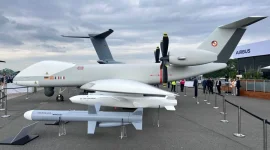- Views: 525
- Replies: 5
In a move signaling a significant shift in its defence strategy, India has joined the Eurodrone program as an observer, indicating its strong interest in acquiring 12 twin-engine Eurodrone Remotely Piloted Aircraft Systems (RPAS).
This development comes alongside India's ongoing acquisition of 30 MQ-9B SeaGuardian and SkyGuardian drones from the United States, highlighting a move towards a multi-layered defence approach and diversified international partnerships.
The Eurodrone, a collaborative project by Airbus Defence and Space, Dassault Aviation, and Leonardo, represents a cutting-edge advancement in unmanned aerial capabilities.
With a substantial payload capacity exceeding 2.3 tonnes, the Eurodrone offers a versatile platform for surveillance, reconnaissance, and precision strike missions. This acquisition would significantly enhance India's existing drone fleet, bolstering its capacity for self-reliance and strategic partnerships in defence technology.
While both the Eurodrone and the MQ-9B platforms offer advanced capabilities, they possess distinct characteristics suited to different operational requirements.
The Eurodrone, with its twin-engine design, emphasizes redundancy and safety, while the MQ-9B's single-engine configuration prioritizes efficiency. The Eurodrone boasts a larger payload capacity, enabling it to carry a wider array of sensors and weaponry, while the MQ-9B excels in long-endurance maritime surveillance.
The acquisition of both the Eurodrone and the MQ-9B will provide India with a complementary set of unmanned platforms, enhancing its defence capabilities across various domains:
- Maritime Domain Awareness: The MQ-9B's long-endurance capabilities make it ideally suited for persistent surveillance over vast oceanic expanses, while the Eurodrone's adaptability allows it to excel in multi-role operations across diverse environments.
- Airspace Superiority: The Eurodrone's payload capacity and interoperability with NATO systems position it as a valuable asset for electronic warfare and intelligence, surveillance, and reconnaissance (ISR) missions in contested airspace, including the Himalayan borders with China and Pakistan.
- Force Multiplication: The integration of both American and European unmanned systems enhances India's operational flexibility and resilience, ensuring a robust response to diverse combat scenarios.
By integrating these advanced unmanned platforms, India is poised to strengthen its strategic autonomy and solidify its position as a leading power in the global aerospace and defence landscape.
The procurement decision also signifies a transition towards a multi-partner approach in India's defence modernization efforts, reducing reliance on any single supplier and fostering greater technological independence.

